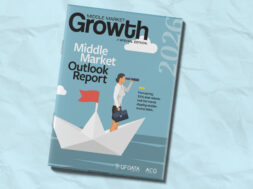Franchise Investors Unlock Revenue Beyond Royalties
From packaged food to home services, the franchise model offers enticing rewards for investors

That potluck staple, the sturdy Bundt cake, is a hot commodity in the franchising world.
Successive infusions of capital from private equity firms with long track records in franchising have frisbeed Nothing Bundt Cakes bakery to national status. In 2016, middle-market private equity firm Levine Leichtman Capital Partners (LLCP) acquired the franchisor from its owners. Just five years later, in a move typical of the accelerating cycle of franchise deals, LLCP sold the fast-rising system to Roark Capital. Now, the bakery has nearly 500 locations in 40 states.
When LLCP offered a buyout to the three owners of Nothing Bundt Cake, two took the money and bowed out, relates LLCP managing partner Matthew Frankel. But the one of the founders “reinvested 100%, because she said the business was still in the early innings of its growth trajectory,” he said. “And that’s what we did. The value of the business grew almost seven-fold in four years.”
The untapped leavening in the Bundt cake niche serves as a tidy case study of current dynamics in the franchise category.
The industry is a growing one, expected to add 15,000 new businesses in 2023. But investing in franchisors requires more due diligence than sampling the goods. The royalty structure might be the cake, but adjacent factors are the icing that top off returns and valuations.
Revenue Beyond Royalties
Franchise systems offer aspiring entrepreneurs a streamlined mode of building their own wealth by buying into an established brand and operational model.
Post-COVID consumer preferences have accelerated favorable trends in the industry, say franchise consultants and investors. As consumers spend less time at home and more time commuting, they are accustomed to outsourcing everything from routine cleaning to seasonal pest maintenance. Likewise, business-to-business franchises are gaining traction as they offer multi-site corporate clients a streamlined way to buy local but ensure systemwide consistency for everything from landscaping to sales training.
Entrepreneurs’ franchise fast track comes at a price: steep royalties are baked in, providing franchisors with a guaranteed revenue stream that buoys ROI. Nothing Bundt Cakes, for instance, scrapes royalty icing of a weekly 6% plus 5% for marketing.
With thousands of franchises to consider, potential acquirers need to understand where a target franchise system is in its growth arc, says Robert Stidham, founder and CEO of Summa, a franchising consulting firm. Once a franchise system pulls free of the gravitational force of fulfilling its obligations to royalty-paying franchisees, the incremental cost of adding more franchises delivers proportionally ever more profit. Investors and marketers say that systemwide expenses like marketing and product development tend to be fixed. As more units join the system, the fixed costs are spread over a larger base, while each unit equally gains from the system infrastructure. That’s when system profits take off, say consultants.
“If you have 100 units each producing $1 million annually, with a 7% royalty, that’s $7 million coming through the door annually, and a well-run franchisor will run that on about $3.5 million,” says Stidham. “The play for the investor is to buy or invest in the franchisor and help them grow their business.”
If you have 100 units each producing $1 million annually, with a 7% royalty, that’s $7 million coming through the door annually, and a well-run franchisor will run that on about $3.5 million.
Robert Stidham
Summa
The vaunted annuity-like revenue stream of royalties (usually 5% to 6%) paid regularly to the franchisor by the franchisee are no longer the only source of recurring income, says Joe Mathews, CEO of consulting firm Franchise Performance Group.
Franchisors can receive rebates or commissions when franchisees buy certain services or products from approved vendors. Some expenses, like marketing services or monthly technology subscriptions, are now baked into the franchise license, bolstering cash flow for franchisors, Mathews says.
“An investor needs to see everything packed into the ‘royalties and fees’ lines,” he says, adding that even events like franchise conventions or white-label technology that franchisees are required to buy can create additional streams of revenue for franchisors.
Running an Efficient Operation
Historically, investors that back franchisors have relied on the appeal of each franchise concept to drive growth, counting on, say, consumer appetite for cake or homeowners’ hatred of household pests. A unique twist on a classic service or product is still the brand concept that attracts consumers and franchisees, but it’s operations that serve up reliable cash flow that satisfies investors.
Ben Lawrence, the Aziz Hashim Professor of Franchise Entrepreneurship at the J. Mack Robinson College of Business at Georgia State University, says the technology on which franchises operate—including tech that facilitates workflows like delivery, ordering and payments—has emerged as the focus of investors.
“The investment in the platform to deliver that brand promise has become more important,” he says. “If you have a brand that has great promise, but it doesn’t have a good tech platform, that’s attractive, because you can improve performance a great deal.”
Information and operations technology is daunting for sole operators, he says, citing the example of app-based ordering and delivery services. But when the cost and effort of building a powerful tech platform is shared across a franchise system, each unit can better compete locally, lifting unit sales and profits, which roll into the system through royalties and fees.
That’s exactly what Frankel oversaw in the decade that Levine Leichtman actively managed Nothing Bundt Cakes, says Frankel.
The firm instituted a new point of sale system that collected details about emerging consumer preferences, which spurred development of new cake flavors and sizes. Consumer data set up targeted marketing based on local buying patterns—a major return for franchisees’ royalties and marketing fees. The firm even rooted around in the pantry, discovering better quality and better-priced versions of production staples, like nonstick spray, that it could integrate into franchisees’ purchasing.
The Private Equity Advantage
Strong revenue streams and cost-effective strategies to drive efficiencies across entire franchise make the category an attractive one for private equity investors. And the operational strategies PE backers deploy can not only impact an entire franchise platform, but all franchises in an investor’s portfolio.
“Spas and facials, home care – these are disparate industries,” Frankel says. “But whether you’re selling lawn care or massages or Bundt cakes, about 70% of what any franchisor does is almost exactly the same.”
PE’s franchise playbook moved to center stage in late August when Roark Capital Group committed to a $9.55 billion purchase of the Subway sandwich system from the founding family. Roark bested 20 competitors for the world’s largest restaurant franchise, which runs 37,000 stores in 100 countries. Roark is a franchisor powerhouse, with stakes in food franchises ranging from pretzels (Auntie Anne’s) to retro burgers (Sonic).
Other recent franchise deals include LLCP’s acquisition of chocolate and ice cream franchisor Kilwin’s Quality Confections, Inc. and Kilwins Chocolates Franchise in February, as well as the September acquisition of home services franchisor Green Home Solutions by NewSpring Franchise, the franchise-focused investment strategy of investment firm NewSpring. Beyond investments in franchises themselves, investors also see opportunity in franchise service providers: lower middle-market private equity firm Southfield Capital announced in July that its portfolio company Franchise FastLane acquired franchise marketing service provider Raintree Franchise Growth.
Experts say the classic franchise unit growth formula is buoyed by the very presence of private equity. Smart franchisees are themselves investors, putting a big chunk of their own savings into the venture; backing from a PE can be a validation of the health and prospects of the system.
According to Frankel, that’s partly why franchise systems tend to weather economic downturns. “One of the reasons why I love to invest in franchisors,” he says, “is that they are counter-cyclical. In a traditional recession, people are laid off and they want to buy a job, and fast. If you’ve saved up $150,000, you can become a franchisee.”
Joanne Cleaver has been covering entrepreneurship and business growth for over 30 years for national media, as both a staff and freelance journalist.
Middle Market Growth is produced by the Association for Corporate Growth. To learn more about the organization and how to become a member, visit www.acg.org.


